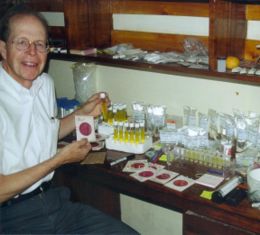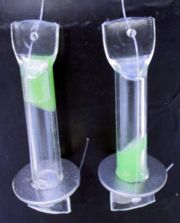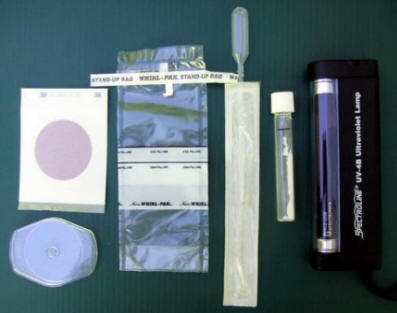Safe Water from Sunshine
 How can Peace Corps volunteers and
other expats living overseas in developing countries be certain their water is
safe to drink? How can they purify it if they’re not sure it’s
safe? Although most volunteers have a personal supply of chlorine
tablets, many of their host country neighbors are not so fortunate. Even
if chlorine tablets are widely distributed as part of regional public health
programs, are they really sustainable? Is there any guarantee that tablets will
be available in the necessary quantities for years to come? Might there
be a more sustainable way to ensure safe drinking water using a free, renewable
energy source? Finally, is it really necessary to boil water to
make it safe?
How can Peace Corps volunteers and
other expats living overseas in developing countries be certain their water is
safe to drink? How can they purify it if they’re not sure it’s
safe? Although most volunteers have a personal supply of chlorine
tablets, many of their host country neighbors are not so fortunate. Even
if chlorine tablets are widely distributed as part of regional public health
programs, are they really sustainable? Is there any guarantee that tablets will
be available in the necessary quantities for years to come? Might there
be a more sustainable way to ensure safe drinking water using a free, renewable
energy source? Finally, is it really necessary to boil water to
make it safe?
The answers to the last two questions,
according to California State University, Sacramento microbiology
professor Dr. Robert
Metcalf are: “Yes, there is a sustainable way to make water safe to
drink using a solar cooker and a
Water Pasteurization Indicator,
(WAPI) and, “No. You do not need to boil
water to make it safe to drink. You need only to pasteurize it at
65°C.” A small number of PCVs
have researched solar cooker technology on the internet and have introduced it
in their villages. As a former PCV in
Paraguay, whose family cooked every day over a wood fire, this is a technology
I wish I had known about
Dr. Metcalf challenges the widespread
claim that water can only be made safe to drink by bringing it to a rapid boil
for several minutes. He approaches the topic of water pasteurization
using well-established concepts of food microbiology. If it actually took
several minutes of a roiling boil to pasteurize water, then what heat treatment
would be required to pasteurize milk? Since microbes survive better
in milk than in water, and since the relatively heat-resistant bacteria that
cause tuberculosis, need to be inactivated in milk, one might assume then that
the dairy industry would have to boil milk for an extended period of time. But
that is not the case. Most milk is flash pasteurized at 71.7°C (161°F) for 15 seconds and raw eggs
are pasteurized at 60°C (140°F) in 3.5 minutes.
 In his work, Dr. Metcalf cites
extensive literature on the times and temperatures needed to kill pathogens in
foods. He reports that the cysts of protozoa, bacteria and rotavirus, which
cause most water-borne disease are inactivated rapidly
at 60°C (140°F), and inactivated very rapidly at 65°C (149°F). He also
notes that these cysts are sometimes able to resist treatment by chlorine,
which is not always able to penetrate the cyst walls unlike 65°C water which
heats the interior of the cyst and denatures critical enzymes.
In his work, Dr. Metcalf cites
extensive literature on the times and temperatures needed to kill pathogens in
foods. He reports that the cysts of protozoa, bacteria and rotavirus, which
cause most water-borne disease are inactivated rapidly
at 60°C (140°F), and inactivated very rapidly at 65°C (149°F). He also
notes that these cysts are sometimes able to resist treatment by chlorine,
which is not always able to penetrate the cyst walls unlike 65°C water which
heats the interior of the cyst and denatures critical enzymes.
Although he endorses the safe water
system approach of the Centers for Disease Control using Water Guard, and the
use of Aquatabs, he has found that solar water pasteurization with the WAPI
provides another option for people who do not have access to chlorine, or find
the taste of chlorinated water objectionable. Furthermore, solar pasteurization
is a sustainable method since the world will never run out of
sunshine.
To pasteurize water in 4-5 liter
batches, Dr. Metcalf uses a panel solar cooker (the
Cookit, which can
be purchased on-line or constructed at minimal cost from scrap cardboard and
aluminum foil) to heat the water. A WAPI is suspended in the pot of water
while it is being heated in the Cookit. When the water reaches 65°C, the
wax plug at the top of the WAPI melts and falls to the bottom of the tube,
indicating that the water has reached pasteurization temperature and it is now
safe to drink. Dr. Metcalf stresses that safe storage of the water in a
clean container after pasteurization is of course essential to maintain its
purity.
 A small, portable manufactured
device for solar pasteurization of water, which might be a useful addition to a
PCV's emergency kit, is the Aquapak,
which contains a built-in WAPI and can pasteurize up to five liters of
water at a time. For large-scale solar water pasteurization
requirements, the Hawaii-based company Safe Water Systems makes the
Sunray 1000, which can solar pasteurize up to 1000 liters of water per day.
Safe Water Systems' homepage notes that, "A 1998 U.S. Dept. of
Energy, National Renewable Energy Laboratory (NREL) study concluded that solar
water pasteurization was superior in most regards to competing technologies,
e.g., chemical, filter and reverse osmosis."
A small, portable manufactured
device for solar pasteurization of water, which might be a useful addition to a
PCV's emergency kit, is the Aquapak,
which contains a built-in WAPI and can pasteurize up to five liters of
water at a time. For large-scale solar water pasteurization
requirements, the Hawaii-based company Safe Water Systems makes the
Sunray 1000, which can solar pasteurize up to 1000 liters of water per day.
Safe Water Systems' homepage notes that, "A 1998 U.S. Dept. of
Energy, National Renewable Energy Laboratory (NREL) study concluded that solar
water pasteurization was superior in most regards to competing technologies,
e.g., chemical, filter and reverse osmosis."
Dr. Metcalf has conducted microbiology
tests in Sacramento, Kenya and Tanzania comparing the solar cooker/WAPI method
of pasteurizing water with the SODIS (solar water disinfection) method in which
water is placed in clear plastic bottles and exposed to sunshine for a
recommended six hours. He found that the SODIS method was not always able to
completely inactivate E. coli in contaminated water even after six hours. In
addition, viruses and protozoan cysts are inactivated by sunshine at a much
slower rate than are bacteria. Thus, sunshine inactivation of bacteria does not
correlate with inactivation of viruses or cysts. He also notes that with the SODIS method
there is no way to know for certain if and when pathogenic bacteria, viruses,
and protozoa have been neutralized.
 For the past six years, Dr. Metcalf has
carried out extensive studies on water testing in the U.S., Kenya, and
Tanzania. He needed to conduct water tests where there was no laboratory,
and he selected commercially available materials used in the water and food
industries to detect the indicator of fecal contamination, the bacterium Escherichia coli. He has assembled a simple-to-use, inexpensive
water testing kit, called the Mobile Microbiology Laboratory, which fits inside
a gallon-size Ziploc plastic bag. Clear results from the two tests are
obtained in 12-18 hours, and the results correlate with WHO guidelines for low,
moderate, high, or very high risk of disease. He has taught unskilled villagers
to use the kit to test their water supplies. Not only do they determine
if their water sources contain fecal microbes, but they also witness how an
invisible bacterial cell can grow into a visible colony of a billion cells
overnight. This leads to a profound understanding of how similar explosive
growth of typhoid, cholera, or dysentery bacteria in their intestine can result
in serious disease. Dr. Metcalf has posted a detailed power point presentation
on water testing using the Mobile Microbiology Laboratory at the following website:
http://imageevent.com/bobmetcalf/watertestingpasteurizationinafrica.
He can be reached at
rmetcalf@csus.edu.
For the past six years, Dr. Metcalf has
carried out extensive studies on water testing in the U.S., Kenya, and
Tanzania. He needed to conduct water tests where there was no laboratory,
and he selected commercially available materials used in the water and food
industries to detect the indicator of fecal contamination, the bacterium Escherichia coli. He has assembled a simple-to-use, inexpensive
water testing kit, called the Mobile Microbiology Laboratory, which fits inside
a gallon-size Ziploc plastic bag. Clear results from the two tests are
obtained in 12-18 hours, and the results correlate with WHO guidelines for low,
moderate, high, or very high risk of disease. He has taught unskilled villagers
to use the kit to test their water supplies. Not only do they determine
if their water sources contain fecal microbes, but they also witness how an
invisible bacterial cell can grow into a visible colony of a billion cells
overnight. This leads to a profound understanding of how similar explosive
growth of typhoid, cholera, or dysentery bacteria in their intestine can result
in serious disease. Dr. Metcalf has posted a detailed power point presentation
on water testing using the Mobile Microbiology Laboratory at the following website:
http://imageevent.com/bobmetcalf/watertestingpasteurizationinafrica.
He can be reached at
rmetcalf@csus.edu.
------
Patricia McArdle, a staunch advocate of solar cooking, joined the board of Solar Household Energy and Solar Cookers International in 2007 to help promote the production of clean, safe, distributable, and renewable energy. Ms. McArdle has more than 30 years of international and public affairs experience.